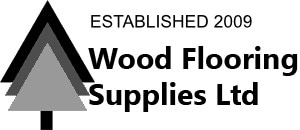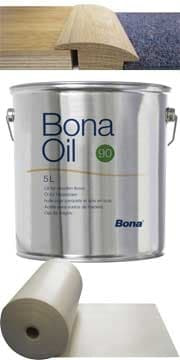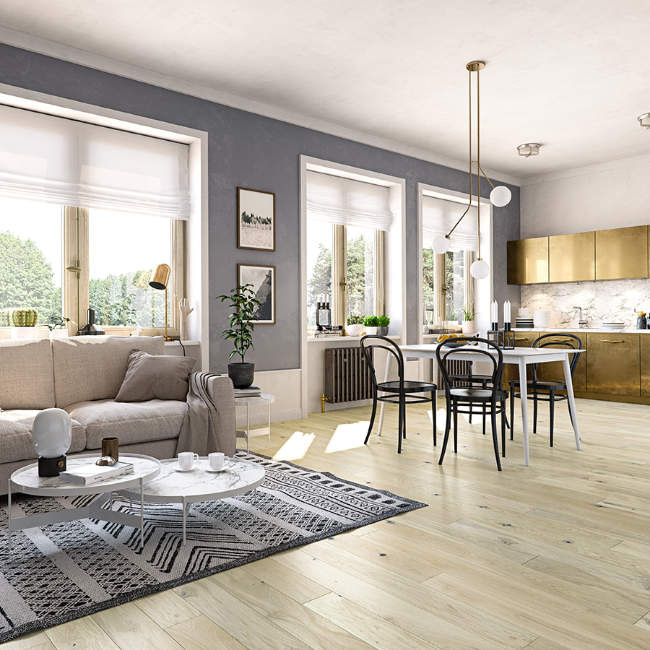Engineered Wood Flooring
Tips Before Installing A Floating Engineered Wood Floor
Tips Before Installing A Floating Engineered Wood Floor
Floating Installations
Engineered wood flooring is generally suitable for laying over water-fed underfloor heating systems. Please contact your supplier for technical information prior to laying.
PRE-INSTALLATION
We recommend a professional floor fitter install your engineered wood floor, these will have the necessary measuring equipment. To keep the wood in excellent condition it is imperative that the humidity level be controlled at all times, from delivery to laying the floor, and during the years that follow installation.
The optimal humidity range for hardwood flooring is 45—60%; temperature should be maintained at about 18°C. Flooring should never be stored outdoors, on a cement floor, in a garage or in any damp conditions. Care should be taken to store the wood flat; packs should never be lent against a wall. Pre-finished boards should be left in the packaging in the room where it is to be laid until you are ready to lay the floor (at least overnight).
In a new construction all windows and doors etc should be installed and all wet trades should be completed. Surface drainage should direct water away from the building. Basements and crawl spaces must be dry. In a newly constructed building, the heating must have been in operation for at least 10 days
prior to the floor being laid. Upon delivery, check wood flooring moisture content with a moisture meter (all flooring contractors should possess one). Test concrete for moisture. A Damp Proof membrane must also be present underneath the concrete, if present, as well as over it. Where a new concrete slab has been laid, the moisture content must not exceed 5% and the humidity level of the building must not exceed 60%. Prior to installation, ensure that wood flooring is within acceptable range of moisture content with the wood subfloor. If not within the acceptable range, then a suitable Damp Proof Membrane should be installed, over the wood subfloor, prior to installation.
In on ground and below ground applications, always add a suitable Damp Proof Membrane. All subfloors must be flat,clean, dry and structurally sound, free of squeaks, and free of protruding nails or staples. All subfloors should be flat to within 3mm over a 3 metre length, or 2mm over a 2 metre length. Remember preparation is key to having a long lasting engineered flooring.
Due to the variety of installations we can only generalise. We would always recommend that the floor layer satisfy themselves of the suitability of the conditions before laying the floor. Do not lay the flooring in areas that are wet or humid, e.g. bathrooms, shower rooms etc.
It should also be remembered that the floor layer is the last person to inspect the flooring. Care should be taken to ensure that a balanced look is maintained when laying out the floor. We recommend when fitting that you choose from 4 boxes at a time to give you a more balanced look. Any pieces that are suspect (too dark or light) be fitted where furniture would be placed.
As a general rule we recommend at least 12-18mm expansion around the perimeter of the room and at doorways. At least 12-18mm expansion must also be left where the floor comes in to contact with any other vertical surfaces. These expansion gaps can be covered by wood beading or skirting boards after installation.
Expansion
Allow 15mm minimum expansion space at all vertical obstructions. Adequate ventilation must exist beneath the wood flooring e.g air bricks around the perimeter of the building. In areas where the flooring comes into contact with a fireplace, stove, heating system or un- insulated hot air vents a layer of asphalt or wax paper should be laid first. This will prevent excess drying out of the wood flooring.
Correct Underlay
Making the right choice of underlay is important for your room. If you have underfloor heating then choose an underlay for maximum heat transfer. Or if if noise is an issue then look for a wood underlay that has a good db rating.
Important To Control Humidity
The appearance of spaces between boards indicates a drying out of the wood and an insufficient degree of humidity. The appearance of waves or noticeable swelling in the finish of the wood floor indicates the presence of excessive humidity. Heating systems may have to be utilised throughout the year to maintain the correct humidity level. The installation of a humidifier or an air exchange system can prove indispensable in controlling humidity.
Above all don’t forget that wood is a natural, living material and that we must look after it for life. A proper maintenance program should always be carried out. Such as – Barrier matting should be placed at all exterior doorways. Remember that pets running round, stiletto heels, and dirt and grit left on the floor can scratch wood; regular maintenance should be carried out to prevent this.



